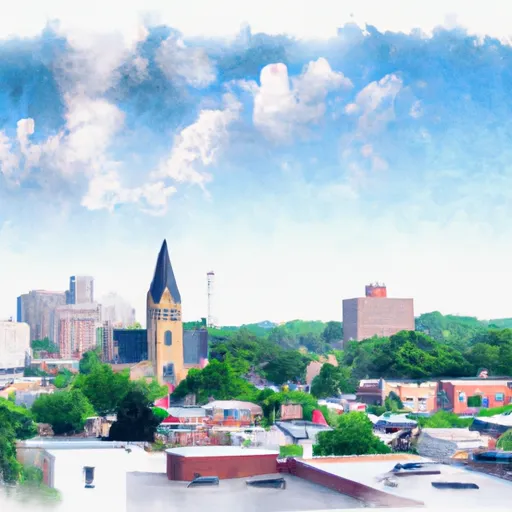-
 Snoflo Premium
Snoflo Premium
Get unlimited access to all our content
With no Ad interruptions! - Start Your Free Trial Login with existing account
Saint-Joseph
Eden Index
Climate
8.1
•
Recreation
3.1
•
Community
3.8
•
Safeguard
5.3/10

Saint-Joseph, Illinois is a charming village located in Champaign County. With a population of approximately 4,000 residents, it offers a peaceful and close-knit community atmosphere. The climate in Saint-Joseph is characterized by hot summers and cold winters, typical of the humid continental climate zone. Summers see temperatures ranging from 70°F to 90°F, while winters can dip as low as 20°F with occasional snowfall.
The village is surrounded by beautiful water bodies, including the Sangamon River and the Salt Fork of the Vermilion River. These hydrology constituents not only enhance the aesthetics of the area but also provide ample opportunities for outdoor recreation. Fishing enthusiasts can enjoy angling for various species like catfish, bass, and bluegill. Boating and kayaking are popular activities, allowing visitors to explore the serene waters and soak in the natural beauty.
Additionally, Saint-Joseph boasts several parks and trails, perfect for hiking, biking, and picnicking. The Salt Fork State Park, located just a short drive away, offers even more opportunities for outdoor adventure, with camping, horseback riding, and hunting available. Saint-Joseph provides a peaceful escape for nature lovers and outdoor enthusiasts seeking to immerse themselves in its scenic surroundings.
What is the Eden Index?
The Snoflo Eden Index serves as a comprehensive rating system for regions, evaluating their desirability through a holistic assessment of climate health, outdoor recreation opportunities, and natural disaster risk, acknowledging the profound impact of these factors on livability and well-being.
Climate Health Indicator (CHI): 8.1
Saint-Joseph receives approximately
998mm of rain per year,
with humidity levels near 84%
and air temperatures averaging around
11°C.
Saint-Joseph has a plant hardyness factor of
5, meaning
plants and agriculture in this region thrive during a short period during spring and early summer. Most
plants will die off during the colder winter months.
By considering the ideal temperature range, reliable water supplies, clean air, and stable seasonal rain or snowpacks, the Climate Health Indicator (CHI) underscores the significance of a healthy climate as the foundation for quality living.
A healthy climate is paramount for ensuring a high quality of life and livability in a region, fostering both physical well-being and environmental harmony. This can be characterized by ideal temperatures, reliable access to water supplies, clean air, and consistent seasonal rain or snowpacks.
Weather Forecast
Streamflow Conditions
Wabash
Area Rivers
Wabash
Snowpack Depths
Wabash
Reservoir Storage Capacity
Wabash
Groundwater Levels
Recreational Opportunity Index (ROI): 3.1
The Recreational Opportunity Index (ROI) recognizes the value of outdoor recreational options, such as parks, hiking trails, camping sites, and fishing spots, while acknowledging that climate plays a pivotal role in ensuring the comfort and consistency of these experiences.
Access to outdoor recreational opportunities, encompassing activities such as parks, hiking, camping, and fishing, is crucial for overall well-being, and the climate plays a pivotal role in enabling and enhancing these experiences, ensuring that individuals can engage in nature-based activities comfortably and consistently.
Camping Areas
| Campground | Campsites | Reservations | Toilets | Showers | Elevation |
|---|---|---|---|---|---|
| Piney - LBL | 300 | 385 ft | |||
| Rushing Creek - LBL | 56 | 402 ft | |||
| Nathan Bedford Forrest State Park | 53 | 437 ft | |||
| Mousetail Landing State Park | 24 | 429 ft | |||
| Boswell Landing | 34 | 406 ft | |||
| Beech Bend | None | 373 ft | |||
| Gatlin Point - LBL | 19 | 453 ft | |||
| Bumpus Mills - Lake Barkley | None | 520 ft | |||
| Paris Landing State Park | 63 | 392 ft | |||
| Gatlin Point | 30 | 433 ft |
Nearby Ski Areas
Catastrophe Safeguard Index (CSI):
The Catastrophe Safeguard Index (CSI) recognizes that natural disaster risk, encompassing floods, fires, hurricanes, and tornadoes, can drastically affect safety and the overall appeal of an area.
The level of natural disaster risk in a region significantly affects safety and the overall livability, with climate change amplifying these risks by potentially increasing the frequency and intensity of events like floods, fires, hurricanes, and tornadoes, thereby posing substantial challenges to community resilience and well-being.
Community Resilience Indicator (CRI): 3.8
The Community Resilience Indicator (CRI) recognizes that education, healthcare, and socioeconomics are crucial to the well-being of a region. The CRI acknowledges the profound impact of these elements on residents' overall quality of life. By evaluating educational resources, healthcare accessibility, and economic inclusivity, the index captures the essential aspects that contribute to a thriving community, fostering resident satisfaction, equity, and social cohesion.

